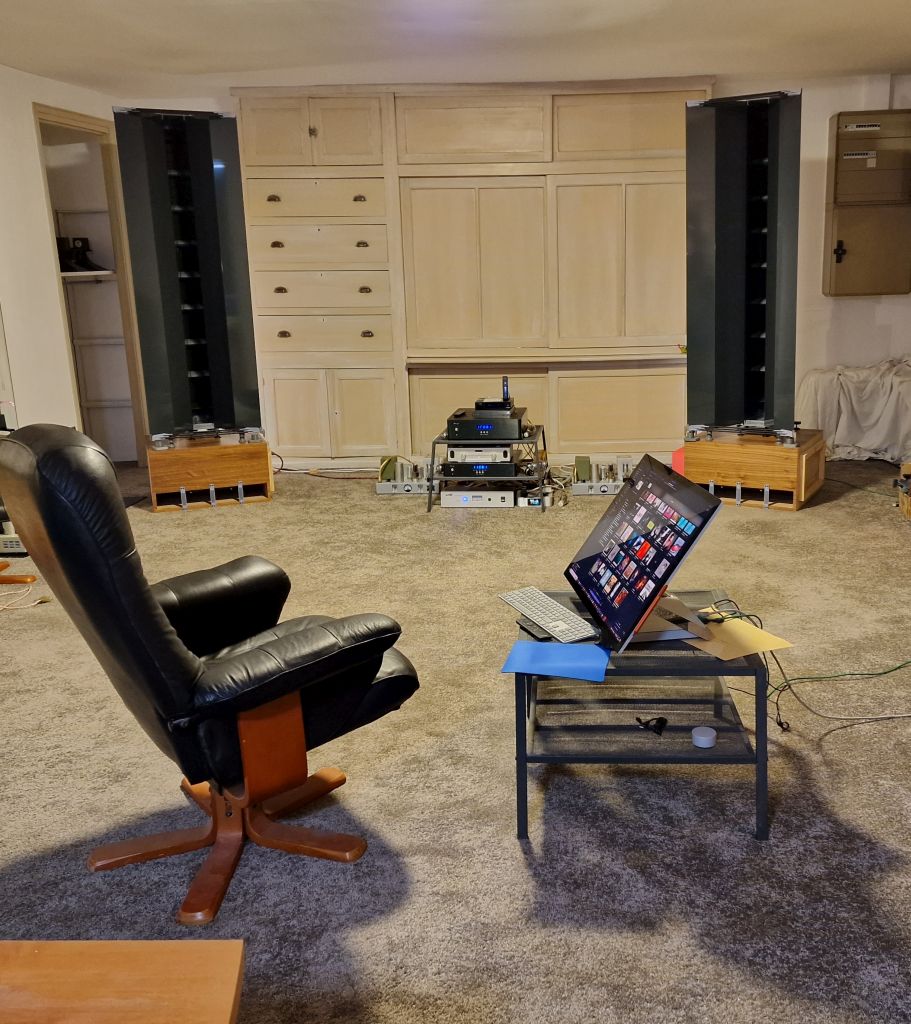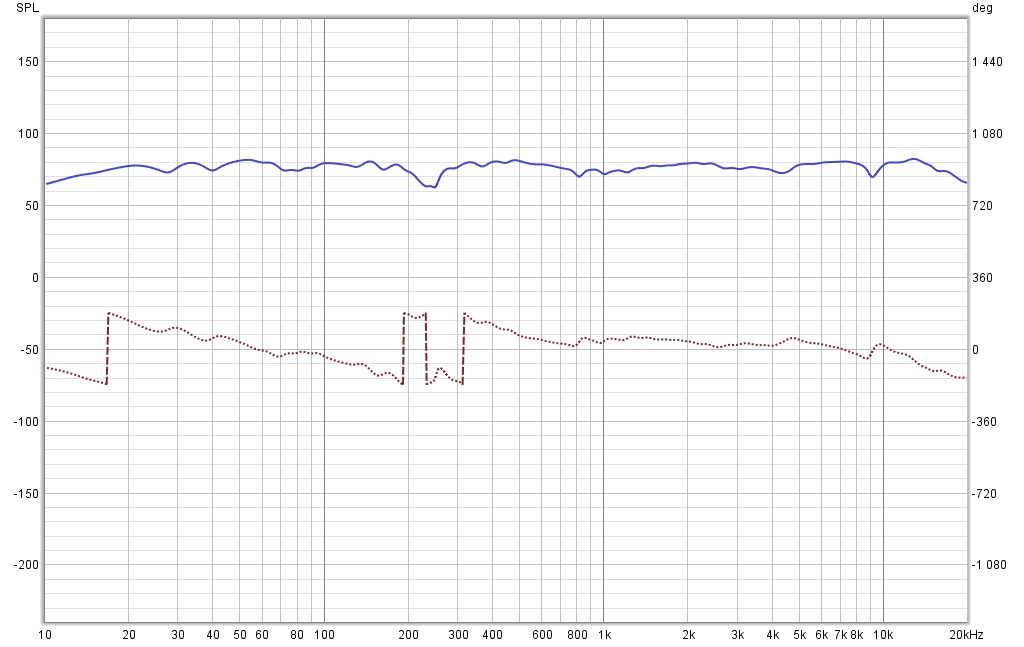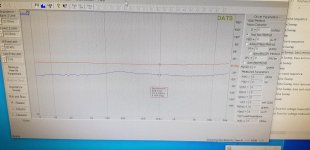Hi sap2212 ,
- Thank you , so much for taking a second look at the numbers .
This is very helpful !
- My thought on the panels was to laminate 1/8 or 1/4 glass to either side of the 1/4 to 1/2 inch pieces of Acrylic . . . . I found some glues specifically made to adhere glass to Acrylic , then less vibration transfer , and no scratches , easy clean up , and less dust being statically attracted to the panels either .
Kind regards , Dean
PS. - after counting all the squares on your grid paper in your original drawing, these measurements are what I ended up with
- of coarse maybe should be cm not mm - LOL . . . still looks like even counting I was wrong- LOL , LOL

- Thank you , so much for taking a second look at the numbers .
This is very helpful !
- My thought on the panels was to laminate 1/8 or 1/4 glass to either side of the 1/4 to 1/2 inch pieces of Acrylic . . . . I found some glues specifically made to adhere glass to Acrylic , then less vibration transfer , and no scratches , easy clean up , and less dust being statically attracted to the panels either .
Kind regards , Dean
PS. - after counting all the squares on your grid paper in your original drawing, these measurements are what I ended up with
- of coarse maybe should be cm not mm - LOL . . . still looks like even counting I was wrong- LOL , LOL
Dear Hallcon 83, I cross the fingers for you with your cancer. Keep on building speakers that helps to get rid of all the thoughts...Hi Tangopaps , and sap 2212
Please no problem , Thank you for the invasion of the Topic ...... 🙂
- I understand your confusion ... I thought maybe one of the numbers was incorrect ..... but I was Really confused , I must have drawn the graphs/ design 15 times trying to figure out what I was doing wrong - LOL, LOL . . .
- Eventually I magnified sap2212's picture and counted all the little squares on the graph
paper .... trying to see what I was doing wrong - LOL
-- I am in the middle of dealing with cancer so I haven't had the money to build this yet...
- I'm not the biggest fan of the gray panels.... I think I would either paint them white , or Veneer them.
- I think the Ultimate would be to build this out of Acrylic . . . maybe 5/8 thick .
! I will try to build the line array. Starting with a quick and dirty prototy with 4 planars. Prototyp is almost finished. Let's see. In six month I'm retired and than I have (hopefully) a lot of time.
Bernhard
Hi sap2212 ,
1. - have you confirmed for sure that the horn needs the lenses? . . .
2. - I was wondering if DSP is needed?
Thank you ,
Kind regards , Dean
1. - have you confirmed for sure that the horn needs the lenses? . . .
2. - I was wondering if DSP is needed?
Thank you ,
Kind regards , Dean
Hi Bernhard ,
- Thank you for your encouragement!
- yes need to keep busy . . . but not to worry - I actually have too many projects - LOL . . . .
- A while back I picked up a number of pairs of vintage speakers at auctions to restore , . . . a pair of Wharfedale W70's , a pair of Kilpsch Heresy speakers, a pair of Design acoustic speakers - ( given to me by a friend ) , a couple of pairs of Cerwin Vega speakers... and a couple vintage Pioneer speakers ... all need a lot of work ...... so a couple need new speaker boxes ..... they all need new crossover parts , new surrounds for drivers , new bracing inside of speakers , and new Veneer on some as well as refinishing others , . . . I'm hoping to finish them all - LOL , LOL . . . . . . and make enough money to fund all of my personal speaker plans!
-----------
-- Good luck on your Prototype horn speaker!!!!
- I'm looking forward to your project!
- What are you using for the Horn Part of the Speaker - are you using the same material as sap2212 used - the Dibond??
- you might talk to sap2212 and ask about 4 planars as a line source , maybe he would know the answer to this question . . . . I was told by some speaker designers - Specifically Danny at GR Research , ( Danny designs speakers for a living there ) -- that if you don't have enough drivers in a row, like in our case only using 4 planars vs 8 planars that the line source wouldn't perform nearly as well..... I'm not sure 100% why . . .
- I think it has to do with possible comb filtering from the drivers . . . . I also had several other speaker guys tell me something similar..
- I never really new if it was true or not . . . . I guess you are about to find out . . . 🙂
- - But I do want to Encourage your building and trying your Prototype Speakers!!!! . . . . but if it doesn't sound great it may need the other 4 Planars drivers to sound right - or maybe sound it's Best ???? . . . just a thought.
- please let us know what you discover!
Thank you ,
Kind regards, Dean
- Thank you for your encouragement!
- yes need to keep busy . . . but not to worry - I actually have too many projects - LOL . . . .
- A while back I picked up a number of pairs of vintage speakers at auctions to restore , . . . a pair of Wharfedale W70's , a pair of Kilpsch Heresy speakers, a pair of Design acoustic speakers - ( given to me by a friend ) , a couple of pairs of Cerwin Vega speakers... and a couple vintage Pioneer speakers ... all need a lot of work ...... so a couple need new speaker boxes ..... they all need new crossover parts , new surrounds for drivers , new bracing inside of speakers , and new Veneer on some as well as refinishing others , . . . I'm hoping to finish them all - LOL , LOL . . . . . . and make enough money to fund all of my personal speaker plans!
-----------
-- Good luck on your Prototype horn speaker!!!!
- I'm looking forward to your project!
- What are you using for the Horn Part of the Speaker - are you using the same material as sap2212 used - the Dibond??
- you might talk to sap2212 and ask about 4 planars as a line source , maybe he would know the answer to this question . . . . I was told by some speaker designers - Specifically Danny at GR Research , ( Danny designs speakers for a living there ) -- that if you don't have enough drivers in a row, like in our case only using 4 planars vs 8 planars that the line source wouldn't perform nearly as well..... I'm not sure 100% why . . .
- I think it has to do with possible comb filtering from the drivers . . . . I also had several other speaker guys tell me something similar..
- I never really new if it was true or not . . . . I guess you are about to find out . . . 🙂
- - But I do want to Encourage your building and trying your Prototype Speakers!!!! . . . . but if it doesn't sound great it may need the other 4 Planars drivers to sound right - or maybe sound it's Best ???? . . . just a thought.
- please let us know what you discover!
Thank you ,
Kind regards, Dean
Hi Dean, Fast Prototyp is ready - using only 4 Planars. Sound is really Amazing- but needs some equalising. Let‘s See. Now I will order 8 Units and build a wood construction (Prototyp 2). My girl Friends is also very happy with the results- she is very tolerant.😊Hi Bernhard ,
- Thank you for your encouragement!
- yes need to keep busy . . . but not to worry - I actually have too many projects - LOL . . . .
- A while back I picked up a number of pairs of vintage speakers at auctions to restore , . . . a pair of Wharfedale W70's , a pair of Kilpsch Heresy speakers, a pair of Design acoustic speakers - ( given to me by a friend ) , a couple of pairs of Cerwin Vega speakers... and a couple vintage Pioneer speakers ... all need a lot of work ...... so a couple need new speaker boxes ..... they all need new crossover parts , new surrounds for drivers , new bracing inside of speakers , and new Veneer on some as well as refinishing others , . . . I'm hoping to finish them all - LOL , LOL . . . . . . and make enough money to fund all of my personal speaker plans!
-----------
-- Good luck on your Prototype horn speaker!!!!
- I'm looking forward to your project!
- What are you using for the Horn Part of the Speaker - are you using the same material as sap2212 used - the Dibond??
- you might talk to sap2212 and ask about 4 planars as a line source , maybe he would know the answer to this question . . . . I was told by some speaker designers - Specifically Danny at GR Research , ( Danny designs speakers for a living there ) -- that if you don't have enough drivers in a row, like in our case only using 4 planars vs 8 planars that the line source wouldn't perform nearly as well..... I'm not sure 100% why . . .
- I think it has to do with possible comb filtering from the drivers . . . . I also had several other speaker guys tell me something similar..
- I never really new if it was true or not . . . . I guess you are about to find out . . . 🙂
- - But I do want to Encourage your building and trying your Prototype Speakers!!!! . . . . but if it doesn't sound great it may need the other 4 Planars drivers to sound right - or maybe sound it's Best ???? . . . just a thought.
- please let us know what you discover!
Thank you ,
Kind regards, Dean
For the sub I have built a H-Frame Sub with Goldwood GW-1858. Very low Performance - but not fast. Need a Slot Open baffle up to 350 Hz! The endless Story …
Sesame is the name of my speakers. The origin comes from a tale of One Thousand and One Nights in which "Open Sesame" is the magic formula to open the door to a cavern filled with treasure. That's the feeling you get when listening to your speakers. The orchestra plays in the room behind the speakers with a very high level of realism. The definition of these speakers is very high, it can be compared to the best current Hifi equipment. The people who gave an opinion on the French Forum use high-end equipment such as Quad 989 speakers. One person compares with these speakers, he writes I have a tractor and sesame, it's a Formula 1. of "Wilson Audio Sophia 1".
Sesame is not magic. The "Line Array" helps to suppress reflections from the listening room.
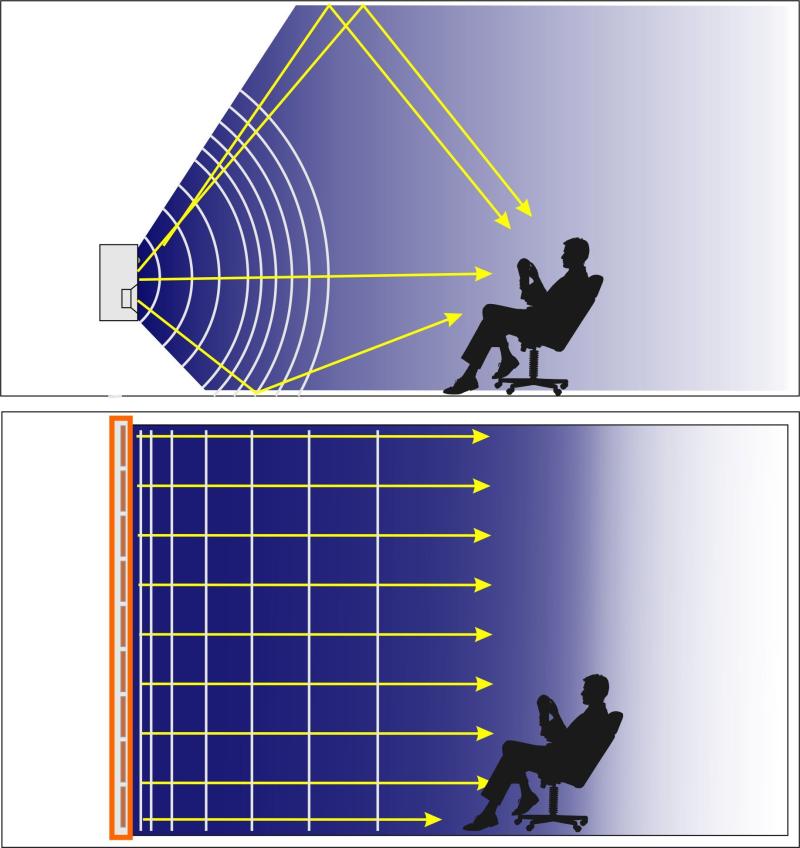
With a conventional loudspeaker, the acoustic radiation is spherical. Part of the waves are reflected by the floor and the ceiling. The listener hears the sound of the speaker added to the reflections. The red curve is the original signal, emitted by the loudspeaker. The blue curve is a reflection by the ground, it arrives with a slight delay. The green curve is the signal heard by the listener. It is the addition of the two curves. The phase and amplitude of the original signal are not respected.
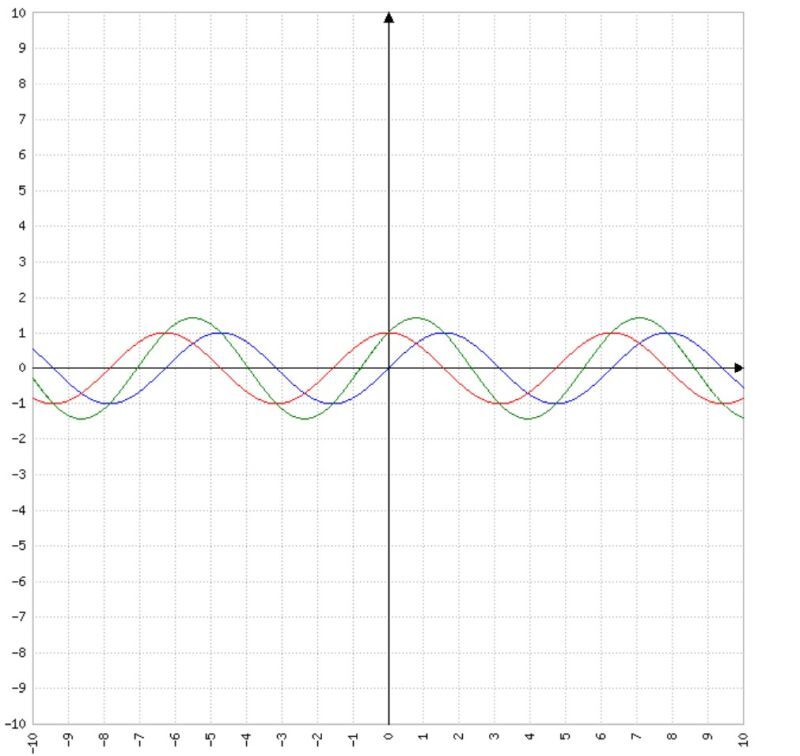
With the "Line Array" the waves are parallel to the floor and the ceiling. There are no reflections. The signal is not polluted by the room. When listening, the music is more detailed and the dynamics are better, as with headphones. The ear and the brain keep only the first sound received. On live recordings, we hear the acoustics of the concert hall, not the acoustics of the listening room.
To have the "Line Array" effect, the enclosure must measure at least 70% of the ceiling height. At home the ceiling is 2.5 m and Sesame is 1.8 m and for that I use eight Neo8s.
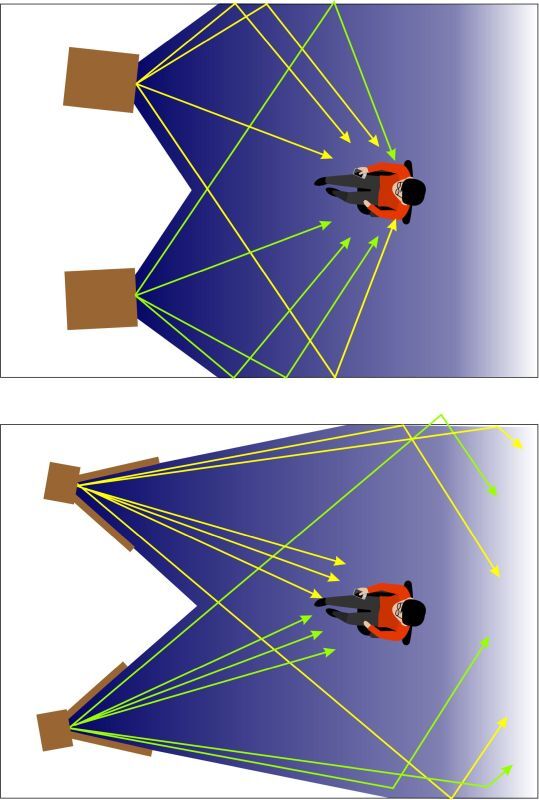
After the reflections of the floor and the ceiling, it is necessary to avoid creating them on the walls. I use directivity from the horns.

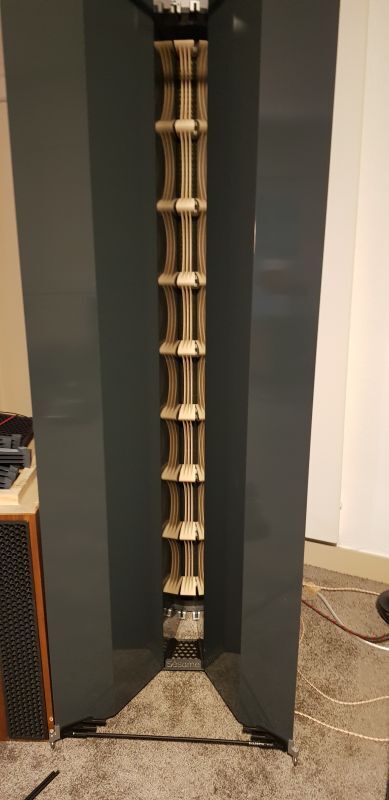
For the use of acoustic lenses, I still have tests to do with a new shape. These lenses were created to fill the gap between two Neo8s and more smoothly adapt the Neo8's planar radiation to the horn. With Sesame there are no comb filtering problems found with "Line Array" composed of multiple small speakers. The small cones have a spherical radiation and the high frequencies are localized in the center of the cone. This causes interference between them. The Neo8 has an elongated shape suitable for in-line mounting, the wave is flat and all frequencies are reproduced by the entire surface.
The lenses give a gain of 1 or 2 dB, but the high cutoff frequency is a little worse. Listening, I find that there is a little more precision. The lenses are made with a Creality Ender-3 3D printer at €180. I will put the plans (STL) online if anyone is interested.
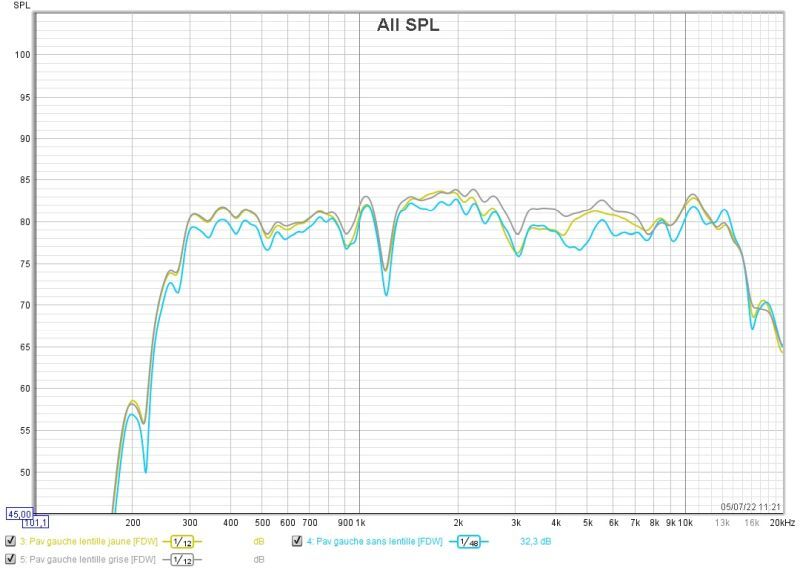
Gray gray lenses. Yellow yellow lentils. Blue without lenses.
Sesame is not magic. The "Line Array" helps to suppress reflections from the listening room.

With a conventional loudspeaker, the acoustic radiation is spherical. Part of the waves are reflected by the floor and the ceiling. The listener hears the sound of the speaker added to the reflections. The red curve is the original signal, emitted by the loudspeaker. The blue curve is a reflection by the ground, it arrives with a slight delay. The green curve is the signal heard by the listener. It is the addition of the two curves. The phase and amplitude of the original signal are not respected.

With the "Line Array" the waves are parallel to the floor and the ceiling. There are no reflections. The signal is not polluted by the room. When listening, the music is more detailed and the dynamics are better, as with headphones. The ear and the brain keep only the first sound received. On live recordings, we hear the acoustics of the concert hall, not the acoustics of the listening room.
To have the "Line Array" effect, the enclosure must measure at least 70% of the ceiling height. At home the ceiling is 2.5 m and Sesame is 1.8 m and for that I use eight Neo8s.

After the reflections of the floor and the ceiling, it is necessary to avoid creating them on the walls. I use directivity from the horns.


For the use of acoustic lenses, I still have tests to do with a new shape. These lenses were created to fill the gap between two Neo8s and more smoothly adapt the Neo8's planar radiation to the horn. With Sesame there are no comb filtering problems found with "Line Array" composed of multiple small speakers. The small cones have a spherical radiation and the high frequencies are localized in the center of the cone. This causes interference between them. The Neo8 has an elongated shape suitable for in-line mounting, the wave is flat and all frequencies are reproduced by the entire surface.
The lenses give a gain of 1 or 2 dB, but the high cutoff frequency is a little worse. Listening, I find that there is a little more precision. The lenses are made with a Creality Ender-3 3D printer at €180. I will put the plans (STL) online if anyone is interested.

Gray gray lenses. Yellow yellow lentils. Blue without lenses.
I use a DSP to filter the speakers. The cut is at 250 Hz at -6 dB with a slope of 48 dB/oct. This frequency is important, and it is the weak point of my system. Below this frequency, the Neo 8s become fragile. And for a subwoofer this is a difficult frequency to reach.
I use the Minidsp SHD Studio with the Dirac streamer and correction function. There are solutions like the MiniDsp Flex or the DCX2496.
All my encouragement to Tangopaps.
I use the Minidsp SHD Studio with the Dirac streamer and correction function. There are solutions like the MiniDsp Flex or the DCX2496.
All my encouragement to Tangopaps.
Hi Sap2212,
Superbe Artisanat!!! I have plans for something similar, but without digital filtering and perhaps with multiple horn entries for small woofers to get the line array frequency down to 120 Hz or lower. May I ask:
1. When you listened to the horn loaded version, but unfiltered version of your speaker, as measured in post #2, did it sound satisfactory in the upper treble region? I ask because it appears to be down -3 dB at about 10.5KHz.
2. How did you wire your speakers in terms of the impedance/resistance load to your amplifier? I ask because it seems to that the most likely choice would yield 12.8 Ohms. If so, was this on purpose? Did you consider using 9 drivers, which could have yielded an impedance of 6.4. Or even 6 drivers to yield 9.6 Ohms?
Superbe Artisanat!!! I have plans for something similar, but without digital filtering and perhaps with multiple horn entries for small woofers to get the line array frequency down to 120 Hz or lower. May I ask:
1. When you listened to the horn loaded version, but unfiltered version of your speaker, as measured in post #2, did it sound satisfactory in the upper treble region? I ask because it appears to be down -3 dB at about 10.5KHz.
2. How did you wire your speakers in terms of the impedance/resistance load to your amplifier? I ask because it seems to that the most likely choice would yield 12.8 Ohms. If so, was this on purpose? Did you consider using 9 drivers, which could have yielded an impedance of 6.4. Or even 6 drivers to yield 9.6 Ohms?
Hello Ben.
My study is made to operate the speakers with a 3.5 W 2A3 SE amplifier. For me, the 2A3 is one of the best tubes, but its tiny power makes it too often give way to the 300B. For me the 2A3 has more realism and presence.
Horns have always been listened to with DSP and 2A3. With 3.5 W the DSP cannot make a positive correction, just lower the level.
However, if I narrow the width of the mouth of the horn the high frequencies go up a bit.
The impedance of these speakers is flat, the phase too, the resonance is very well damped. The impedance of each panel is 13 ohms. A turbulent impedance curve hurts many amps. Here no problem for the 2A3 on 8 ohm, but with a loss of power. But I use 3K output transformers for 300B. It's easier to find than good transformers for 2A3. and the possibility of using output transformers for 300B on 16 ohm. The impedance seen by the amplifier is 2.4 K.
My study is made to operate the speakers with a 3.5 W 2A3 SE amplifier. For me, the 2A3 is one of the best tubes, but its tiny power makes it too often give way to the 300B. For me the 2A3 has more realism and presence.
Horns have always been listened to with DSP and 2A3. With 3.5 W the DSP cannot make a positive correction, just lower the level.
However, if I narrow the width of the mouth of the horn the high frequencies go up a bit.
The impedance of these speakers is flat, the phase too, the resonance is very well damped. The impedance of each panel is 13 ohms. A turbulent impedance curve hurts many amps. Here no problem for the 2A3 on 8 ohm, but with a loss of power. But I use 3K output transformers for 300B. It's easier to find than good transformers for 2A3. and the possibility of using output transformers for 300B on 16 ohm. The impedance seen by the amplifier is 2.4 K.
Attachments
Hi Sap2212,
Thank you for your reply.
Yes, the vénérable 2AE. I have a Chinese single ended 829B amplifier and am building a 6V6 from scratch. One day maybe I will build a 2AE amplifier.
May I ask if the horn that yielded the response curve seen in post #2 had the same width of mouth as the horn that yielded the response curves seen in posts #27 and #30?
I ask because the response curve in post #2 is down 3dB at about 10.5KHz, while, in contrast, the response curve in post #27 extends to about 14KHz (-3dB) and in post #30 to about 16.5KHz (-3dB).
From POst #2

From Post #27

From Post #30

If the horn mouth/overall shape did not change, then are we to conclude that the differences in recorded treble extension are due to the acoustic lenses in #27 and digital filtering as well as the lenses in #30?
And Tangopaps,
Are you happy with the high frequency extension in your 4 x PT6825 Horned Array? Did you use any lenses or digital filtering? Will you be showing photos, plans, or measurements too?
Kind Regards,
Ben
Thank you for your reply.
Yes, the vénérable 2AE. I have a Chinese single ended 829B amplifier and am building a 6V6 from scratch. One day maybe I will build a 2AE amplifier.
May I ask if the horn that yielded the response curve seen in post #2 had the same width of mouth as the horn that yielded the response curves seen in posts #27 and #30?
I ask because the response curve in post #2 is down 3dB at about 10.5KHz, while, in contrast, the response curve in post #27 extends to about 14KHz (-3dB) and in post #30 to about 16.5KHz (-3dB).
From POst #2
From Post #27
From Post #30
If the horn mouth/overall shape did not change, then are we to conclude that the differences in recorded treble extension are due to the acoustic lenses in #27 and digital filtering as well as the lenses in #30?
And Tangopaps,
Are you happy with the high frequency extension in your 4 x PT6825 Horned Array? Did you use any lenses or digital filtering? Will you be showing photos, plans, or measurements too?
Kind Regards,
Ben
To have the "Line Array" effect, the enclosure must measure at least 70% of the ceiling height.
Where is this rule from?
This is a little off subject but I have old VMPS speakers using similar neo8 drivers (3) and a Constant Directivity Wave Guide that I have heard is a disaster - I am thinking of improving them with a better wave guide and DSP.


Any suggestions?
Where is this rule from?
This is a little off subject but I have old VMPS speakers using similar neo8 drivers (3) and a Constant Directivity Wave Guide that I have heard is a disaster - I am thinking of improving them with a better wave guide and DSP.
Any suggestions?
@ Ben
We cannot make a comparison on the curves.
Curve #2 is that of the prototype. It has an opening of 80 cm and the material is Wedi® #10. This material is absorbent at high frequencies.
The walls of the final horn are adjustable in opening.
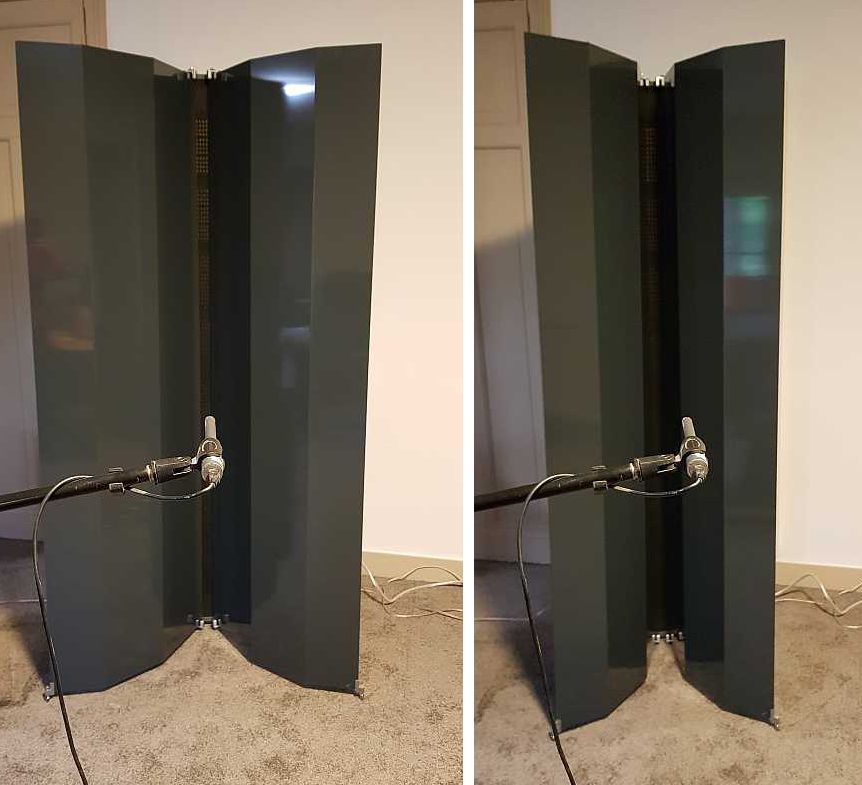
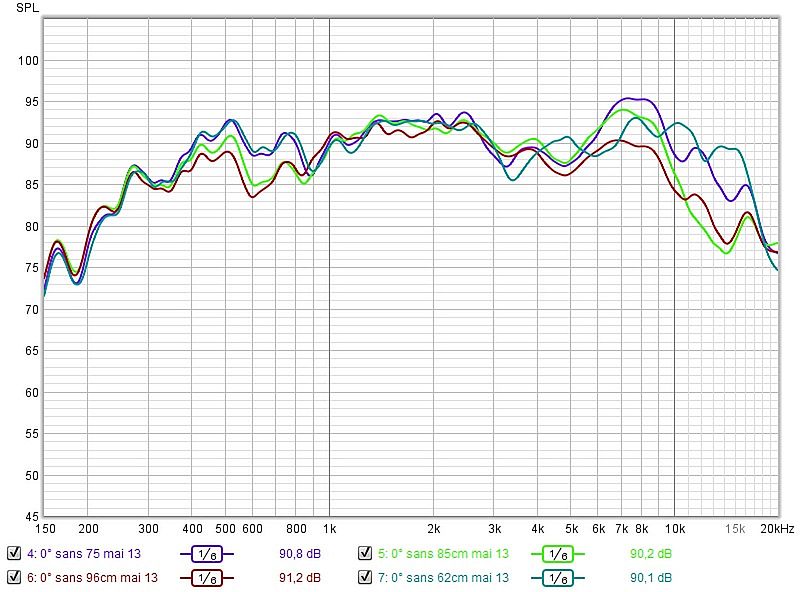
They are made of Dibond® (aluminum / polyethylene / aluminum) which is more favorable to high frequencies.
A comparison measurement 75 cm, 85 cm, 96 cm and 62 cm in blue.
Acoustic lenses are useless. I was afraid of creating a problem by leaving the gaps between the Neo8s empty. On measurements and listening, there is no significant difference. I left the parts in place, as they give rigidity.
I am very satisfied with listening to this Horned Array. I had beautiful horn or electrostatic speakers, but I realize with hindsight that it is often the amplifier that limited the quality of the speakers, but also of the source. Every time I upgrade my 2A3, I find that the DAC is better.
Here a link to a French forum, with opinions from people who have listened. http://forum-hifi.fr/thread-23663.html On page 7 someone says his speakers are a tractor compared to a Formula 1. He has Wilson Audio Sophia 1 speakers.
The most characteristic of the sound of the Horned Array is the sound image.
I am attaching a REW measurement file. The measurement is made with 2A3 amps, this is why the H2 distortion is a bit high. I lowered the Dirac corrections to limit this, but the H2 is not perceived as unpleasant.
@ tbrooke
To have the "Line Array" effect, the enclosure must measure at least 70% of the ceiling height.
There is a mirror effect which enlarges the length of the Line Array. https://audioroundtable.com/misc/nflawp.pdf
The plane wave and spherical wave mix cannot work correctly, the attenuations are not the same. The speakers are good individually, but not together.
We cannot make a comparison on the curves.
Curve #2 is that of the prototype. It has an opening of 80 cm and the material is Wedi® #10. This material is absorbent at high frequencies.
The walls of the final horn are adjustable in opening.


They are made of Dibond® (aluminum / polyethylene / aluminum) which is more favorable to high frequencies.
A comparison measurement 75 cm, 85 cm, 96 cm and 62 cm in blue.
Acoustic lenses are useless. I was afraid of creating a problem by leaving the gaps between the Neo8s empty. On measurements and listening, there is no significant difference. I left the parts in place, as they give rigidity.
I am very satisfied with listening to this Horned Array. I had beautiful horn or electrostatic speakers, but I realize with hindsight that it is often the amplifier that limited the quality of the speakers, but also of the source. Every time I upgrade my 2A3, I find that the DAC is better.
Here a link to a French forum, with opinions from people who have listened. http://forum-hifi.fr/thread-23663.html On page 7 someone says his speakers are a tractor compared to a Formula 1. He has Wilson Audio Sophia 1 speakers.
The most characteristic of the sound of the Horned Array is the sound image.
I am attaching a REW measurement file. The measurement is made with 2A3 amps, this is why the H2 distortion is a bit high. I lowered the Dirac corrections to limit this, but the H2 is not perceived as unpleasant.
@ tbrooke
To have the "Line Array" effect, the enclosure must measure at least 70% of the ceiling height.
There is a mirror effect which enlarges the length of the Line Array. https://audioroundtable.com/misc/nflawp.pdf
The plane wave and spherical wave mix cannot work correctly, the attenuations are not the same. The speakers are good individually, but not together.
Attachments
Hi Sap2212,
With Regard to he shape of the horn in post 18, is that the final shape you used with the 63 cm mouth? Is that horn shape a known curve such as Oblate Spheroid, Exponential, or Tractrix e.t.c.?

Also, may I ask how close you were able to get the horn to the outside holes in the PT6825? It seems there are little ridges that would prevent getting right up to the edge of said holes.

Hi tbrooke,
I believe there were some glowing reviews of VMPS back in the day. Danny from GR Research highlighted some shortcomings and from my reading of authors such as Jim Reeves they don't obey the line array guidlines, but if they sound good to your ears...why not just enjoy them? For my two cents worth, I wonder if just getting planar magnetics into one's system for midrange and treble might just have certain sonic advantages over conventional cone speakers that its worth it even if they are only form truncated arrays with monopole tweeters.
I am wondering about trying a long MTM D'Appolito with a line of four or so PT6825 (or PT5010 with PT mini-6 tweeters blocking the middle two rows in the PT5010) in a horn with two 8 inch drivers above and below crossed at 1.2 x wavelength. However, I should probably start a new thread to find out more about that idea.
Kind Regards,
Ben
With Regard to he shape of the horn in post 18, is that the final shape you used with the 63 cm mouth? Is that horn shape a known curve such as Oblate Spheroid, Exponential, or Tractrix e.t.c.?
Also, may I ask how close you were able to get the horn to the outside holes in the PT6825? It seems there are little ridges that would prevent getting right up to the edge of said holes.
Hi tbrooke,
I believe there were some glowing reviews of VMPS back in the day. Danny from GR Research highlighted some shortcomings and from my reading of authors such as Jim Reeves they don't obey the line array guidlines, but if they sound good to your ears...why not just enjoy them? For my two cents worth, I wonder if just getting planar magnetics into one's system for midrange and treble might just have certain sonic advantages over conventional cone speakers that its worth it even if they are only form truncated arrays with monopole tweeters.
I am wondering about trying a long MTM D'Appolito with a line of four or so PT6825 (or PT5010 with PT mini-6 tweeters blocking the middle two rows in the PT5010) in a horn with two 8 inch drivers above and below crossed at 1.2 x wavelength. However, I should probably start a new thread to find out more about that idea.
Kind Regards,
Ben
The curve is not a mathematical curve. I created it by testing and measuring with panels glued with adhesive tape. The mouth is 63 cm. We could certainly improve the horn with a more regular profile. The broken curves seem to cause disturbances as can be seen on this forum.
https://www.diy-hifi-forum.eu/forum...oder-Constant-Directivity-wie-geht-das/page37
It has notches on the lenses so it won't touch the Neo8s. The horn and the support panel of the Neo8 are two separate parts. They don't touch each other. It is very important not to transmit the vibrations. The space between the two is about 3 mm.
At the bottom each rests on the ground with an axis to fix the spacing and the opening of the horn. At the top, a hinge is the only contact.
https://www.diy-hifi-forum.eu/forum...oder-Constant-Directivity-wie-geht-das/page37
It has notches on the lenses so it won't touch the Neo8s. The horn and the support panel of the Neo8 are two separate parts. They don't touch each other. It is very important not to transmit the vibrations. The space between the two is about 3 mm.
At the bottom each rests on the ground with an axis to fix the spacing and the opening of the horn. At the top, a hinge is the only contact.
- Home
- Loudspeakers
- Planars & Exotics
- Help Please, can 7 or 8 of these new tweeter/ Midrange planars be used in a Line Array?
